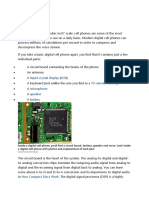0% found this document useful (0 votes)
36 views10 pagesConsumer Electronics Notes
The document provides an overview of the essential components and workings of mobile phones, dishwashers, refrigerators, vacuum cleaners, and microwave ovens. It details the parts of a mobile phone, including the circuit board, display technologies, battery, system-on-a-chip, memory, modems, cameras, and sensors, as well as the functioning of household appliances like dishwashers and refrigerators. Additionally, it explains the principles behind the operation of these devices, emphasizing their technological features and components.
Uploaded by
charanksyadavCopyright
© © All Rights Reserved
We take content rights seriously. If you suspect this is your content, claim it here.
Available Formats
Download as DOCX, PDF, TXT or read online on Scribd
0% found this document useful (0 votes)
36 views10 pagesConsumer Electronics Notes
The document provides an overview of the essential components and workings of mobile phones, dishwashers, refrigerators, vacuum cleaners, and microwave ovens. It details the parts of a mobile phone, including the circuit board, display technologies, battery, system-on-a-chip, memory, modems, cameras, and sensors, as well as the functioning of household appliances like dishwashers and refrigerators. Additionally, it explains the principles behind the operation of these devices, emphasizing their technological features and components.
Uploaded by
charanksyadavCopyright
© © All Rights Reserved
We take content rights seriously. If you suspect this is your content, claim it here.
Available Formats
Download as DOCX, PDF, TXT or read online on Scribd
/ 10
























































































